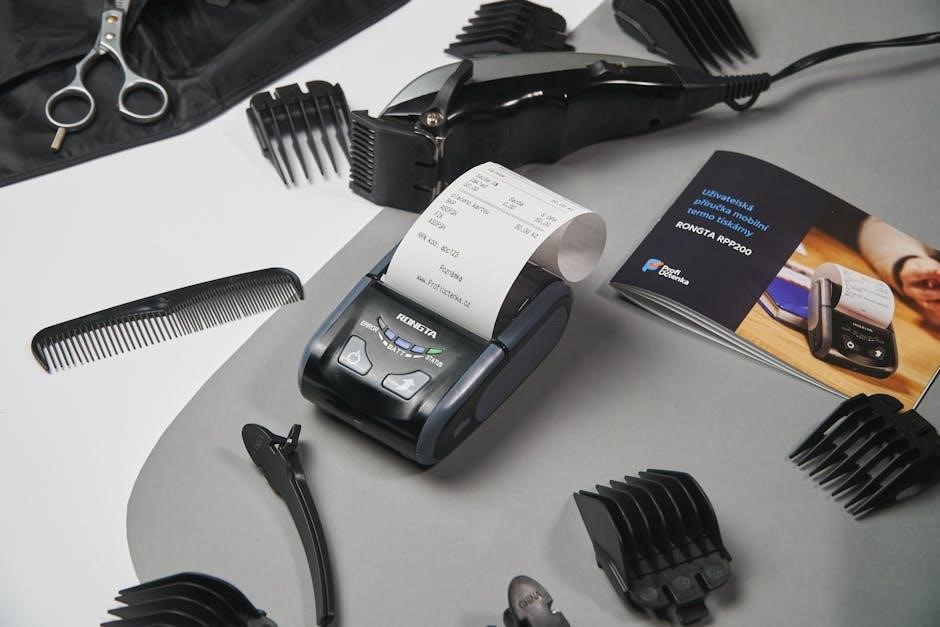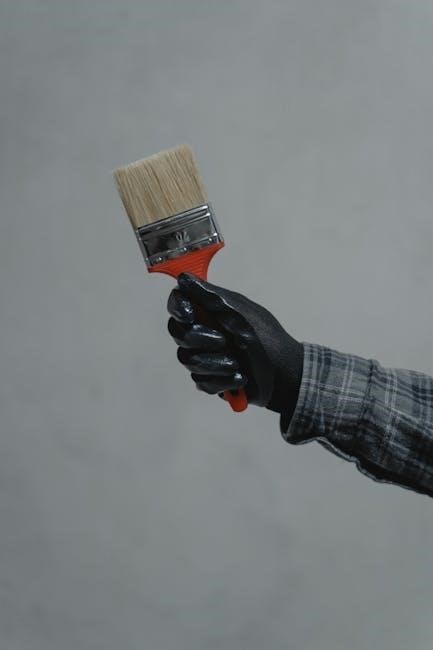A brush cutter is a versatile tool designed for cutting thick vegetation‚ grass‚ and small shrubs. Available in petrol‚ electric‚ and cordless models‚ it efficiently maintains outdoor spaces‚ ideal for larger areas where standard trimmers fall short.
1.1 Definition and Purpose of Brush Cutters
A brush cutter is a powerful outdoor tool designed to cut thick vegetation‚ grass‚ and small shrubs. It is typically used for maintaining large areas where standard grass trimmers are insufficient. Available in petrol‚ electric‚ and cordless models‚ brush cutters are versatile and efficient for handling tough overgrowth. Their robust design allows them to tackle dense brush and weeds‚ making them ideal for landscaping‚ agricultural‚ and gardening tasks. Safety and proper usage are emphasized in manuals to ensure effective operation and prevent accidents. Regular maintenance is also crucial for optimal performance and longevity of the equipment.
1.2 Types of Brush Cutters (Petrol‚ Electric‚ Cordless)
Brush cutters are available in three main types: petrol‚ electric‚ and cordless. Petrol models are robust and suitable for heavy-duty tasks‚ offering high power for thick vegetation. Electric brush cutters are eco-friendly‚ quieter‚ and ideal for smaller areas‚ with lower maintenance costs. Cordless versions provide portability and convenience‚ powered by rechargeable batteries‚ perfect for medium-sized tasks. Each type caters to different needs‚ ensuring efficient cutting performance. Manuals for each variant emphasize specific safety guidelines and operational tips‚ helping users choose the right tool for their landscaping or agricultural requirements. Proper selection ensures optimal results and safety during operation.

Safety Precautions
Always wear protective gear‚ ensure proper assembly‚ and keep children and pets away. Follow manual guidelines to avoid accidents and ensure safe operation of the brush cutter.
2.1 Personal Protective Equipment (PPE)
Wear essential PPE‚ including safety glasses‚ gloves‚ long pants‚ and sturdy boots. A helmet and face shield protect against debris. Ensure proper fit and compliance with safety standards to minimize injury risks during operation.
2.2 Operational Warnings and Safety Guidelines
Always read the manual before use. Ensure the area is clear of obstacles and bystanders. Maintain a firm grip and operate on stable ground. Avoid cutting near open flames or sparks. Use cutting tools appropriate for the task. Never modify the equipment‚ and follow all manufacturer guidelines to ensure safe operation and prevent accidents.
2.3 Child and Pet Safety
Keep children and pets at least 15 feet away during operation. Never allow children to operate the brush cutter‚ as it is not a toy. Ensure they understand the dangers of moving parts and sharp blades. Store the brush cutter out of reach when not in use. Secure it in a locked area to prevent accidental access. Always supervise children in areas where the brush cutter is stored or used. Protect pets by keeping them indoors or in a safe‚ fenced area during operation.

Components of a Brush Cutter
A brush cutter consists of an engine‚ flexible shaft‚ drive shaft‚ cutting head‚ and handle. These components work together to enable efficient cutting of various vegetation types.
3.1 Engine and Fuel System
The engine is the heart of a brush cutter‚ typically a 2-cycle petrol engine designed for high power and efficiency. It requires a precise fuel mixture of petrol and oil to ensure optimal performance. The fuel system includes a tank‚ fuel lines‚ and a carburetor‚ which must be maintained to prevent clogging. Regular cleaning of the air filter and fuel-line inspection are crucial to avoid engine issues. Always use high-quality fuel to maintain engine longevity and performance. Proper fuel system care ensures reliable operation and extends the lifespan of the brush cutter.
3.2 Flexible Shaft and Drive Shaft
The flexible shaft and drive shaft are critical components that transmit power from the engine to the cutting head. The flexible shaft allows for easy maneuverability‚ bending around obstacles while maintaining torque. The drive shaft connects the engine to the cutting head‚ ensuring efficient power transfer. Proper alignment and tightening during assembly are essential for smooth operation. Regular inspection for wear or damage is recommended to prevent breakdowns. Lubrication of moving parts in these shafts helps reduce friction and prolongs their lifespan. Ensure all connections are secure before use to maintain optimal performance and safety during operation.
3.3 Cutting Head and Blades
The cutting head and blades are essential for a brush cutter’s functionality. The cutting head houses the blades or nylon strings‚ which vary in type and thickness for different tasks. Metal blades are durable and ideal for thick vegetation‚ while nylon strings are suitable for lighter grass trimming. Proper attachment and alignment of blades ensure efficient cutting and safety. Regular inspection for wear or damage is crucial. Sharpening or replacing blades when necessary maintains performance. Always use the correct blade type for your task to avoid damage and ensure optimal results. Replace worn or damaged blades promptly to maintain effectiveness and safety.
3.4 Handle and Control Mechanisms
The handle and control mechanisms are designed for comfortable operation and precise control. Many brush cutters feature ergonomic D-handles or loop handles‚ reducing fatigue during extended use. Controls include throttle triggers‚ safety switches‚ and blade engagement levers. These mechanisms ensure easy starting‚ speed adjustment‚ and safe operation. Some models offer adjustable handles to fit different user heights. Proper grip and stance are essential for maintaining control. Regularly inspect handle mounts and tighten any loose bolts to prevent vibration issues. The handle’s design plays a key role in maneuverability‚ making it easier to navigate uneven terrain and dense vegetation safely and efficiently.

Assembly and Disassembly
Assembly involves attaching the drive shaft‚ cutting head‚ and debris shield. Follow manual instructions to ensure correct installation. Disassembly is necessary for maintenance and storage.
4.1 Assembling the Drive Shaft
Assembling the drive shaft is crucial for proper brush cutter operation. Begin by inserting the flexible shaft into the drive shaft housing‚ ensuring it aligns correctly. Secure the connection using the provided locking nut‚ tightening firmly. Refer to the manual for specific torque settings. Proper assembly ensures smooth power transmission from the engine to the cutting head‚ minimizing vibration and ensuring efficient performance. Always double-check the connection before use to prevent operational issues. Improper assembly can lead to reduced efficiency or equipment damage.
4.2 Attaching the Cutting Head
Attaching the cutting head is essential for functionality. Align the head with the drive shaft‚ ensuring the mounting holes match. Secure it using the provided bolts or nuts‚ tightening evenly. For nylon string heads‚ ensure the spool aligns correctly. For metal blade heads‚ verify the blade is properly seated and balanced. Tighten all connections firmly to prevent loosening during use. Refer to the manual for specific torque recommendations. Proper attachment ensures safe and efficient cutting performance. Always double-check the head’s alignment and security before operating the brush cutter to avoid accidents or equipment damage.
4.3 Installing the Debris Shield
Position the debris shield over the cutting area‚ ensuring it aligns with the brush cutter’s frame. Secure it using the provided screws or clips‚ tightening firmly to prevent movement during operation. Ensure the shield covers the entire cutting head to deflect debris effectively. For some models‚ the shield may attach via a spring-loaded mechanism; release the spring to lock it in place. Always verify the shield’s position and security before use to protect yourself and bystanders from flying debris. Proper installation is critical for both safety and cutting efficiency. Refer to your manual for model-specific instructions if needed.
4.4 Disassembling for Maintenance
Begin by disconnecting the drive shaft from the engine and cutting head using the appropriate tools. Remove the screws or bolts securing these components. Carefully detach the cutting head and debris shield‚ ensuring not to damage any blades or parts. For the engine‚ use basic tools to dismantle it‚ taking note of any special instructions or diagrams. Handle the flexible shaft with care to avoid bending. Keep track of all removed screws and bolts‚ perhaps using a container or laying them out in order. Consider taking pictures or referencing a video for guidance. Ensure all parts and tools are accounted for before starting. Reassemble by reversing the steps‚ ensuring everything is securely fastened and properly aligned.

Operational Instructions
Start the engine by priming and choking‚ then advance the throttle. Adjust the cutting head angle for optimal results. Use steady‚ sweeping motions for efficient cutting and proper shutdown procedures.
5.1 Starting the Engine
To start the brush cutter’s engine‚ ensure the fuel tank is filled with the recommended fuel mixture. Prime the engine by pressing the primer bulb 2-3 times. Engage the choke and pull the starter handle firmly until the engine coughs. Release the choke gradually and allow the engine to warm up for a few seconds. For electric or cordless models‚ simply plug in or insert the battery and press the ignition button. Always wear personal protective equipment and ensure the area is clear of debris before starting. Follow the manual’s specific instructions for your model to ensure safe and proper engine startup.
5.2 Adjusting the Cutting Head
Adjusting the cutting head ensures optimal performance and safety. For nylon line heads‚ check the line length and ensure it’s properly wound. For metal blade heads‚ secure the blade tightly. Always disconnect the spark plug before making adjustments. Use the provided wrench to tighten or loosen bolts as needed. Ensure the cutting head is balanced and aligned with the shaft. Refer to the manual for specific instructions on your model. Proper adjustment prevents vibration and enhances cutting efficiency. Wear protective gear during adjustments to avoid accidents. Regular checks ensure the cutting head operates effectively and extends the tool’s lifespan. Follow manufacturer guidelines for best results.
5.3 Cutting Techniques for Different Terrains
Adapt your cutting technique based on terrain for efficient results. On flat ground‚ maintain a steady pace and keep the blade parallel to the surface. For slopes‚ cut uphill to avoid slipping and use a slower‚ controlled motion. In dense vegetation‚ use a side-to-side sweeping motion with the blade at a slight angle. For uneven terrain‚ raise the cutting head slightly to avoid damaging the blade. Always adjust the cutting angle to match the terrain‚ ensuring safety and effectiveness. This approach minimizes wear on the tool and maximizes cutting performance across various landscapes. Proper technique ensures precision and prolongs equipment lifespan.
5.4 Shutting Down the Engine
To shut down the brush cutter safely‚ first stop the cutting operation and allow the blade to come to a complete stop. Move the machine to a clear‚ flat area away from flammable materials. For petrol models‚ turn off the ignition switch and ensure the engine cools down before storing. For electric or cordless models‚ disconnect the power source. Always engage the safety lock if available. Proper shutdown prevents accidental start-ups and ensures the machine remains in good working condition. Follow these steps consistently to maintain safety and prolong the lifespan of your brush cutter.

Maintenance and Upkeep
Regular maintenance ensures optimal performance and longevity of your brush cutter. Clean the machine after use‚ lubricate moving parts‚ and inspect for damage or wear.
6.1 Cleaning the Brush Cutter
Regular cleaning is essential for maintaining your brush cutter’s efficiency and longevity. Start by turning off the engine and allowing it to cool. Use a soft brush or cloth to remove dirt‚ grass clippings‚ and debris from the exterior‚ paying special attention to the engine‚ shaft‚ and cutting head. Avoid using harsh chemicals or high-pressure washes‚ as they may damage components. For tougher residue‚ a mild soap solution can be applied‚ but ensure all parts are thoroughly rinsed and dried. Cleaning after each use prevents corrosion and ensures the brush cutter remains in optimal working condition.
6.2 Lubricating Moving Parts
Regular lubrication of moving parts is crucial to ensure smooth operation and extend the lifespan of your brush cutter. Apply a high-quality silicone-based spray or grease to pivot points‚ gears‚ and any moving components. Avoid over-lubrication‚ as it can attract dust and dirt. Pay particular attention to the drive shaft‚ cutting head‚ and handle joints. Lubricate after cleaning and before storage to prevent rust. Always refer to your manual for specific lubrication recommendations‚ as different models may require particular types of lubricants. Proper lubrication reduces friction‚ minimizes wear‚ and ensures optimal performance during use. Consistency is key for maintaining efficiency and durability.
6.3 Sharpening or Replacing Blades
Regular blade maintenance is essential for optimal performance. For metal blades‚ sharpen them with a file or grinder‚ ensuring balanced cutting edges. Always disconnect the spark plug for safety. Nylon blades cannot be sharpened and must be replaced when worn or damaged. Inspect blades frequently and replace them if bent or dull. Use only manufacturer-recommended blades to maintain efficiency and safety. Proper blade care reduces vibration‚ improves cutting accuracy‚ and extends the tool’s lifespan. Sharpen or replace blades as needed to ensure reliable operation and minimize wear on other components. Regular checks prevent unexpected breakdowns during use.
6.4 Winter Storage Tips

Proper winter storage protects your brush cutter from damage. Drain old fuel to prevent degradation and corrosion. Clean the unit thoroughly‚ removing dirt and debris. Store in a dry‚ cool place‚ away from direct sunlight. For petrol models‚ consider adding a fuel stabilizer or draining the tank. Inspect blades for damage and store them separately if possible. Lubricate moving parts to prevent rust. Cover the machine to protect from dust and moisture. Regular storage checks ensure your brush cutter remains in good condition for the next season. Follow these steps to maintain your tool’s performance and longevity during the off-season.

Troubleshooting Common Issues
Identify and resolve common problems like engine failure‚ poor cutting performance‚ or vibrations. Regular maintenance and consulting the manual can help address these issues effectively.
7.1 Engine Not Starting
If the engine fails to start‚ check the fuel level and ensure it’s the correct type. Verify the air filter is clean and free of debris. Inspect the spark plug for wear or fouling and replace it if necessary. Check the ignition system for proper functionality. Ensure the choke is operating correctly and there are no blockages in the fuel line or carburetor. Consult the manual for specific troubleshooting steps‚ and if issues persist‚ contact a professional for assistance. Regular maintenance can help prevent such problems and ensure optimal performance.
7.2 Poor Cutting Performance
Poor cutting performance can result from dull or damaged blades. Regularly inspect and sharpen or replace cutting edges. Ensure the correct blade type is used for the task—metal blades for thick vegetation and nylon for lighter growth. Check the tension of nylon cords; improper tension reduces efficiency. Keep the cutting head free from debris‚ as blockages can hinder performance. Adjust the cutting angle to suit the terrain and material. If issues persist‚ consult the manual for specific blade recommendations or consider professional sharpening. Proper maintenance ensures optimal cutting efficiency and extends the lifespan of the brush cutter.
7.3 Vibration or Noise Issues
Vibration or excessive noise in a brush cutter often indicates improper balancing or worn components. Check for loose screws or bolts and tighten them. Inspect the cutting head and blades for damage or misalignment. A damaged or unbalanced blade can cause vibration. Replace worn or bent blades and ensure proper installation. Lubricate moving parts‚ such as the flexible shaft‚ to reduce friction. If noise persists‚ inspect the engine and muffler for damage or blockages. Refer to the manual for specific troubleshooting steps or consider professional maintenance to restore smooth operation and minimize noise levels.
7.4 Fuel System Problems
Fuel system issues in brush cutters can stem from clogged air filters‚ stale fuel‚ or blocked fuel lines. Regularly clean or replace the air filter to ensure proper airflow. Drain old fuel and refill with fresh‚ correctly mixed petrol-oil mixture. Inspect fuel lines for kinks or blockages and replace if damaged. If problems persist‚ check the fuel tank vent for obstruction. Consult the manual for specific instructions on diagnosing and repairing fuel system components. Proper maintenance and timely addressing of these issues will ensure optimal performance and prevent engine damage.

Environmental Considerations
Proper use and disposal of brush cutters minimize environmental impact. Follow guidelines for waste disposal and fuel management to reduce ecological harm and promote sustainability.
8.1 Reducing Noise Pollution
Brush cutters generate significant noise‚ with levels around 98-112 dB(A). To reduce noise pollution‚ operate during less busy hours and maintain equipment properly. Regularly check and replace worn parts‚ as they can increase noise levels. Consider using electric or cordless models‚ which are generally quieter than petrol-powered options. Additionally‚ wear hearing protection during use to safeguard your hearing. Proper storage and maintenance can also minimize noise output. Always follow manufacturers’ guidelines for noise reduction and environmental care.
8.2 Minimizing Emissions
Brush cutters‚ especially petrol models‚ emit pollutants that contribute to environmental degradation. To minimize emissions‚ opt for electric or cordless versions‚ which produce zero direct emissions. Regularly maintain the engine‚ ensuring proper tuning and air filter cleaning to optimize fuel efficiency. Use the correct fuel type as recommended by the manufacturer to prevent excessive emissions. Avoid prolonged idling and operate the device at appropriate RPM levels. Store fuel properly and dispose of waste responsibly. By adhering to these practices‚ you can significantly reduce the environmental impact of your brush cutter while maintaining its performance.
8;3 Proper Waste Disposal
Proper waste disposal is crucial for maintaining environmental health. Dispose of used cutting blades‚ worn-out parts‚ and expired fuel responsibly. Recycle metal components whenever possible and check local regulations for hazardous waste guidelines. Do not discard brush cutter waste in water bodies or open spaces. Package used oil and filters securely for recycling. Ensure all plastic and packaging materials are appropriately recycled or disposed of through designated channels; By following these practices‚ you contribute to sustainable waste management and reduce ecological impact. Always adhere to local and environmental regulations for waste disposal.
A brush cutter is an essential tool for maintaining outdoor spaces‚ offering versatility and efficiency. Always follow safety guidelines‚ maintain the equipment‚ and dispose of waste responsibly. Thank you for choosing a reliable brush cutter for your needs.
9.1 Summary of Key Points
A brush cutter is a powerful tool for cutting thick vegetation‚ grass‚ and small shrubs. It consists of an engine‚ flexible shaft‚ and cutting head‚ available in petrol‚ electric‚ or cordless models. Always wear PPE‚ including gloves‚ goggles‚ and sturdy footwear‚ and ensure child and pet safety. Proper assembly‚ maintenance‚ and regular sharpening of blades are crucial for optimal performance. Follow operational guidelines‚ store the unit in a dry area‚ and dispose of waste responsibly. Troubleshoot common issues like engine problems or poor cutting performance promptly. Consult the manual for detailed instructions and manufacturer support for any queries.
9.2 Final Safety Reminders
Always prioritize safety when operating a brush cutter. Wear protective gear‚ including gloves‚ goggles‚ and sturdy footwear. Ensure the area is clear of children and pets. Never modify the equipment or use it near flammable materials. Store the brush cutter in a dry‚ secure location after use. Regularly inspect and maintain the machine to prevent malfunctions. Follow all instructions in the manual and avoid overreaching or operating in unsafe conditions. Properly dispose of waste and fuels to protect the environment. Remember‚ safety is paramount to ensure effective and accident-free operation.

Additional Resources
For further assistance‚ refer to manufacturer manuals‚ online forums‚ and professional services. These resources provide detailed guidance‚ troubleshooting tips‚ and expert advice for optimal brush cutter use and maintenance.
10.1 Manufacturer Support and Manuals
Manufacturer-provided manuals are essential for understanding your brush cutter’s operation‚ safety‚ and maintenance. These guides detail proper assembly‚ usage‚ and troubleshooting‚ ensuring optimal performance. Brands like Honda and STIHL offer comprehensive manuals‚ often available online‚ covering engine specifics‚ cutting head adjustments‚ and fuel system care. They emphasize safety precautions and recommended working techniques. Regularly consulting these manuals helps prevent accidents and extends the tool’s lifespan. Additionally‚ manufacturer support teams are available for technical queries‚ providing expert advice tailored to your model. Always follow the manual’s guidelines for assembly‚ maintenance‚ and operation to ensure safe and effective use of your brush cutter.
10.2 Online Forums and Communities
Online forums and communities are invaluable resources for brush cutter users. Platforms like Reddit‚ gardening forums‚ and specialized DIY communities offer troubleshooting tips‚ maintenance advice‚ and user experiences. These spaces allow users to share knowledge‚ resolve common issues‚ and learn from experts. Many forums also feature discussions on product recommendations‚ cutting techniques‚ and safety practices. Engaging with these communities can enhance your understanding of brush cutter operation and maintenance. Additionally‚ manufacturer-specific forums often provide model-specific guidance‚ helping you optimize your tool’s performance and address unique challenges effectively. Active participation can lead to improved efficiency and safer usage of your brush cutter.
10.3 Professional Maintenance Services
Professional maintenance services are essential for ensuring the longevity and optimal performance of your brush cutter. Trained technicians can diagnose and repair complex issues‚ such as engine problems or damaged cutting heads‚ that may be beyond DIY capabilities. Many manufacturers offer authorized service centers that provide genuine parts and expert care. Additionally‚ local small engine repair shops often specialize in brush cutter maintenance‚ offering services like blade sharpening‚ fuel system cleaning‚ and seasonal tune-ups. Regular professional maintenance can prevent costly repairs‚ enhance safety‚ and keep your brush cutter running efficiently for years to come‚ ensuring reliable performance in demanding tasks.
